Analyzing HRM Challenges in a Globalized and Tech-Driven World
VerifiedAdded on 2021/06/17
|9
|2810
|51
Report
AI Summary
This report explores the profound impact of globalization and technological advancements on Human Resource Management (HRM). It delves into how these forces reshape organizational culture, individual behavior, and the nature of work itself. The report examines the changes brought about by globalization, including increased workforce diversity, shifts in morality, evolving employment conditions, and migration patterns. It then analyzes the effects of technological revolutions, such as changes in communication, increased employee efficiency, the rise of remote working, and the growth of freelancing, while also addressing the blurring of time boundaries and improved employee engagement. The report further identifies key challenges faced by HR professionals and organizations, such as adapting hiring and retention strategies, managing diverse workforces, addressing work-life balance issues, and staying current with evolving labor laws. Finally, it outlines the specific competencies required of HR professionals to navigate these challenges effectively, emphasizing the need for credible activism, technological proficiency, and the ability to innovate and integrate HR practices around critical business issues. The report concludes by highlighting the importance of HR professionals adapting to the changing business environment and developing strategies to support employee behavior.
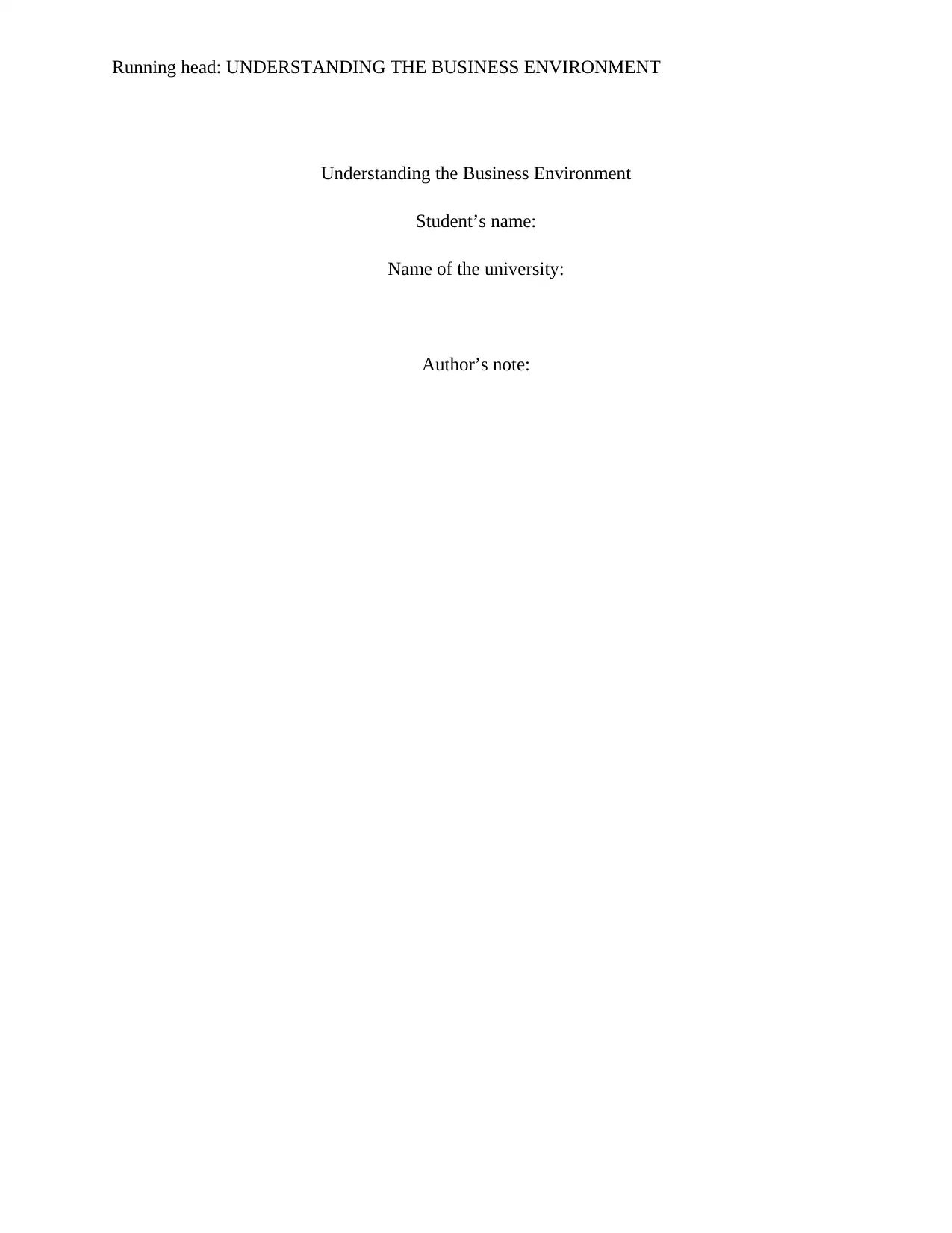
Running head: UNDERSTANDING THE BUSINESS ENVIRONMENT
Understanding the Business Environment
Student’s name:
Name of the university:
Author’s note:
Understanding the Business Environment
Student’s name:
Name of the university:
Author’s note:
Paraphrase This Document
Need a fresh take? Get an instant paraphrase of this document with our AI Paraphraser
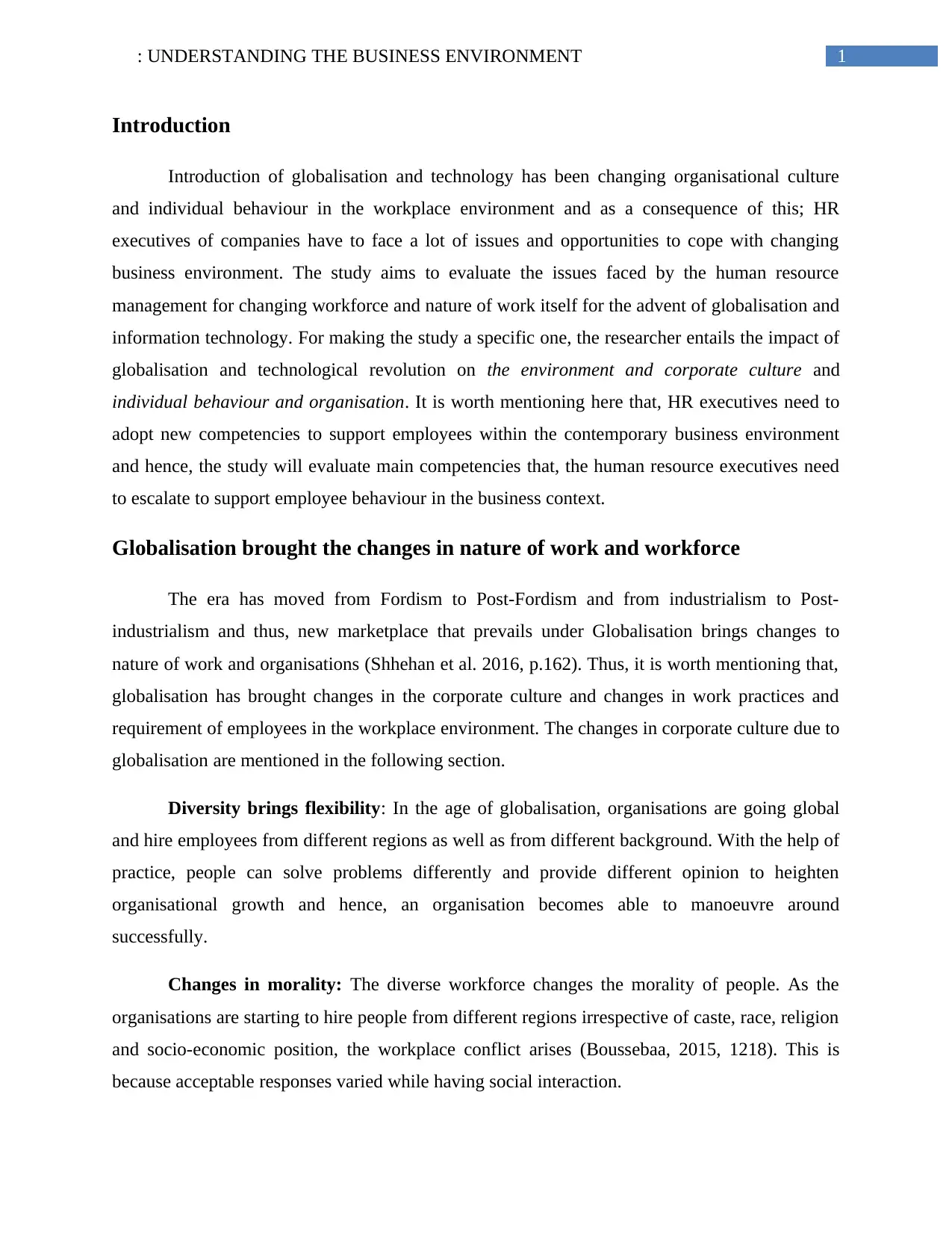
1: UNDERSTANDING THE BUSINESS ENVIRONMENT
Introduction
Introduction of globalisation and technology has been changing organisational culture
and individual behaviour in the workplace environment and as a consequence of this; HR
executives of companies have to face a lot of issues and opportunities to cope with changing
business environment. The study aims to evaluate the issues faced by the human resource
management for changing workforce and nature of work itself for the advent of globalisation and
information technology. For making the study a specific one, the researcher entails the impact of
globalisation and technological revolution on the environment and corporate culture and
individual behaviour and organisation. It is worth mentioning here that, HR executives need to
adopt new competencies to support employees within the contemporary business environment
and hence, the study will evaluate main competencies that, the human resource executives need
to escalate to support employee behaviour in the business context.
Globalisation brought the changes in nature of work and workforce
The era has moved from Fordism to Post-Fordism and from industrialism to Post-
industrialism and thus, new marketplace that prevails under Globalisation brings changes to
nature of work and organisations (Shhehan et al. 2016, p.162). Thus, it is worth mentioning that,
globalisation has brought changes in the corporate culture and changes in work practices and
requirement of employees in the workplace environment. The changes in corporate culture due to
globalisation are mentioned in the following section.
Diversity brings flexibility: In the age of globalisation, organisations are going global
and hire employees from different regions as well as from different background. With the help of
practice, people can solve problems differently and provide different opinion to heighten
organisational growth and hence, an organisation becomes able to manoeuvre around
successfully.
Changes in morality: The diverse workforce changes the morality of people. As the
organisations are starting to hire people from different regions irrespective of caste, race, religion
and socio-economic position, the workplace conflict arises (Boussebaa, 2015, 1218). This is
because acceptable responses varied while having social interaction.
Introduction
Introduction of globalisation and technology has been changing organisational culture
and individual behaviour in the workplace environment and as a consequence of this; HR
executives of companies have to face a lot of issues and opportunities to cope with changing
business environment. The study aims to evaluate the issues faced by the human resource
management for changing workforce and nature of work itself for the advent of globalisation and
information technology. For making the study a specific one, the researcher entails the impact of
globalisation and technological revolution on the environment and corporate culture and
individual behaviour and organisation. It is worth mentioning here that, HR executives need to
adopt new competencies to support employees within the contemporary business environment
and hence, the study will evaluate main competencies that, the human resource executives need
to escalate to support employee behaviour in the business context.
Globalisation brought the changes in nature of work and workforce
The era has moved from Fordism to Post-Fordism and from industrialism to Post-
industrialism and thus, new marketplace that prevails under Globalisation brings changes to
nature of work and organisations (Shhehan et al. 2016, p.162). Thus, it is worth mentioning that,
globalisation has brought changes in the corporate culture and changes in work practices and
requirement of employees in the workplace environment. The changes in corporate culture due to
globalisation are mentioned in the following section.
Diversity brings flexibility: In the age of globalisation, organisations are going global
and hire employees from different regions as well as from different background. With the help of
practice, people can solve problems differently and provide different opinion to heighten
organisational growth and hence, an organisation becomes able to manoeuvre around
successfully.
Changes in morality: The diverse workforce changes the morality of people. As the
organisations are starting to hire people from different regions irrespective of caste, race, religion
and socio-economic position, the workplace conflict arises (Boussebaa, 2015, 1218). This is
because acceptable responses varied while having social interaction.
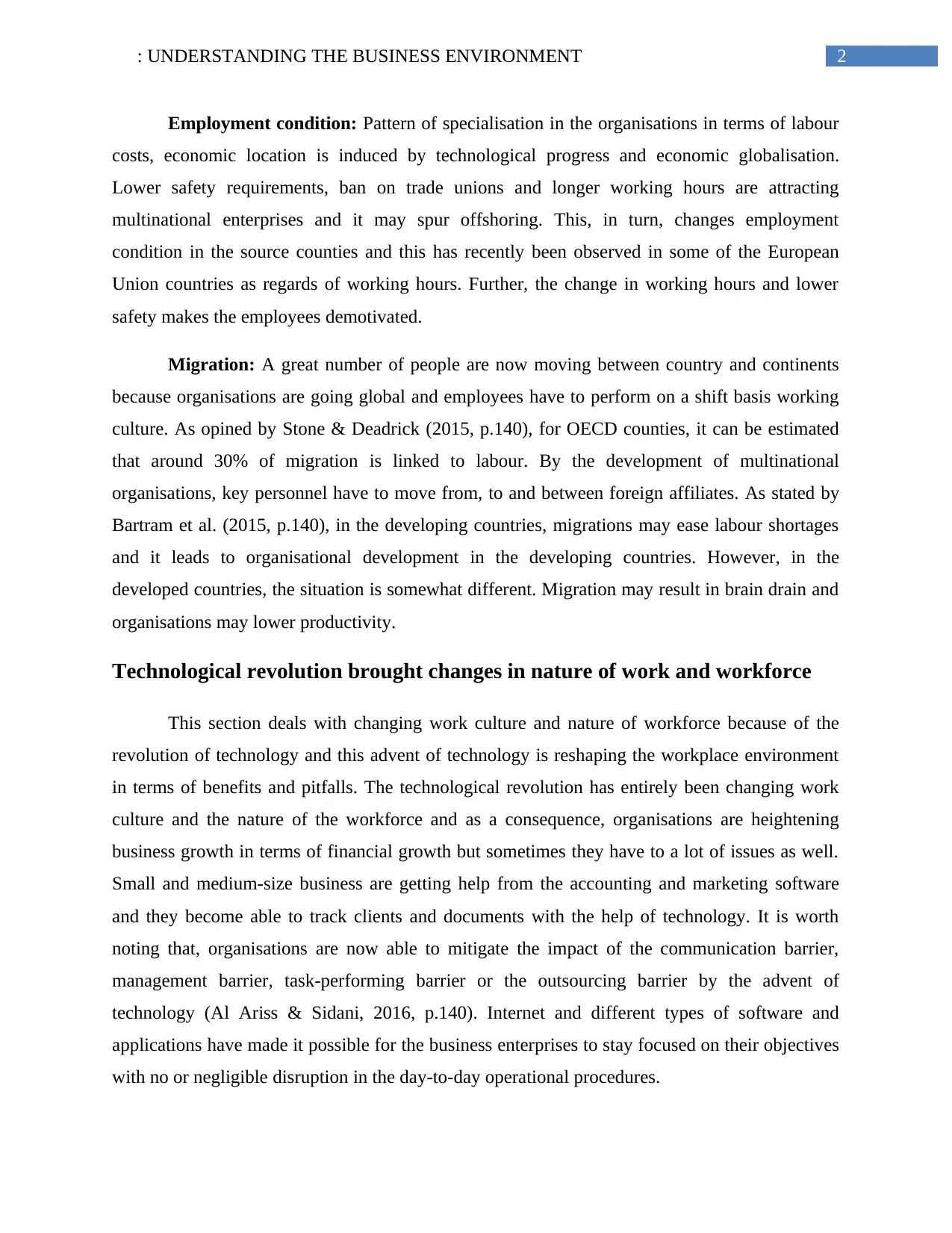
2: UNDERSTANDING THE BUSINESS ENVIRONMENT
Employment condition: Pattern of specialisation in the organisations in terms of labour
costs, economic location is induced by technological progress and economic globalisation.
Lower safety requirements, ban on trade unions and longer working hours are attracting
multinational enterprises and it may spur offshoring. This, in turn, changes employment
condition in the source counties and this has recently been observed in some of the European
Union countries as regards of working hours. Further, the change in working hours and lower
safety makes the employees demotivated.
Migration: A great number of people are now moving between country and continents
because organisations are going global and employees have to perform on a shift basis working
culture. As opined by Stone & Deadrick (2015, p.140), for OECD counties, it can be estimated
that around 30% of migration is linked to labour. By the development of multinational
organisations, key personnel have to move from, to and between foreign affiliates. As stated by
Bartram et al. (2015, p.140), in the developing countries, migrations may ease labour shortages
and it leads to organisational development in the developing countries. However, in the
developed countries, the situation is somewhat different. Migration may result in brain drain and
organisations may lower productivity.
Technological revolution brought changes in nature of work and workforce
This section deals with changing work culture and nature of workforce because of the
revolution of technology and this advent of technology is reshaping the workplace environment
in terms of benefits and pitfalls. The technological revolution has entirely been changing work
culture and the nature of the workforce and as a consequence, organisations are heightening
business growth in terms of financial growth but sometimes they have to a lot of issues as well.
Small and medium-size business are getting help from the accounting and marketing software
and they become able to track clients and documents with the help of technology. It is worth
noting that, organisations are now able to mitigate the impact of the communication barrier,
management barrier, task-performing barrier or the outsourcing barrier by the advent of
technology (Al Ariss & Sidani, 2016, p.140). Internet and different types of software and
applications have made it possible for the business enterprises to stay focused on their objectives
with no or negligible disruption in the day-to-day operational procedures.
Employment condition: Pattern of specialisation in the organisations in terms of labour
costs, economic location is induced by technological progress and economic globalisation.
Lower safety requirements, ban on trade unions and longer working hours are attracting
multinational enterprises and it may spur offshoring. This, in turn, changes employment
condition in the source counties and this has recently been observed in some of the European
Union countries as regards of working hours. Further, the change in working hours and lower
safety makes the employees demotivated.
Migration: A great number of people are now moving between country and continents
because organisations are going global and employees have to perform on a shift basis working
culture. As opined by Stone & Deadrick (2015, p.140), for OECD counties, it can be estimated
that around 30% of migration is linked to labour. By the development of multinational
organisations, key personnel have to move from, to and between foreign affiliates. As stated by
Bartram et al. (2015, p.140), in the developing countries, migrations may ease labour shortages
and it leads to organisational development in the developing countries. However, in the
developed countries, the situation is somewhat different. Migration may result in brain drain and
organisations may lower productivity.
Technological revolution brought changes in nature of work and workforce
This section deals with changing work culture and nature of workforce because of the
revolution of technology and this advent of technology is reshaping the workplace environment
in terms of benefits and pitfalls. The technological revolution has entirely been changing work
culture and the nature of the workforce and as a consequence, organisations are heightening
business growth in terms of financial growth but sometimes they have to a lot of issues as well.
Small and medium-size business are getting help from the accounting and marketing software
and they become able to track clients and documents with the help of technology. It is worth
noting that, organisations are now able to mitigate the impact of the communication barrier,
management barrier, task-performing barrier or the outsourcing barrier by the advent of
technology (Al Ariss & Sidani, 2016, p.140). Internet and different types of software and
applications have made it possible for the business enterprises to stay focused on their objectives
with no or negligible disruption in the day-to-day operational procedures.
⊘ This is a preview!⊘
Do you want full access?
Subscribe today to unlock all pages.

Trusted by 1+ million students worldwide
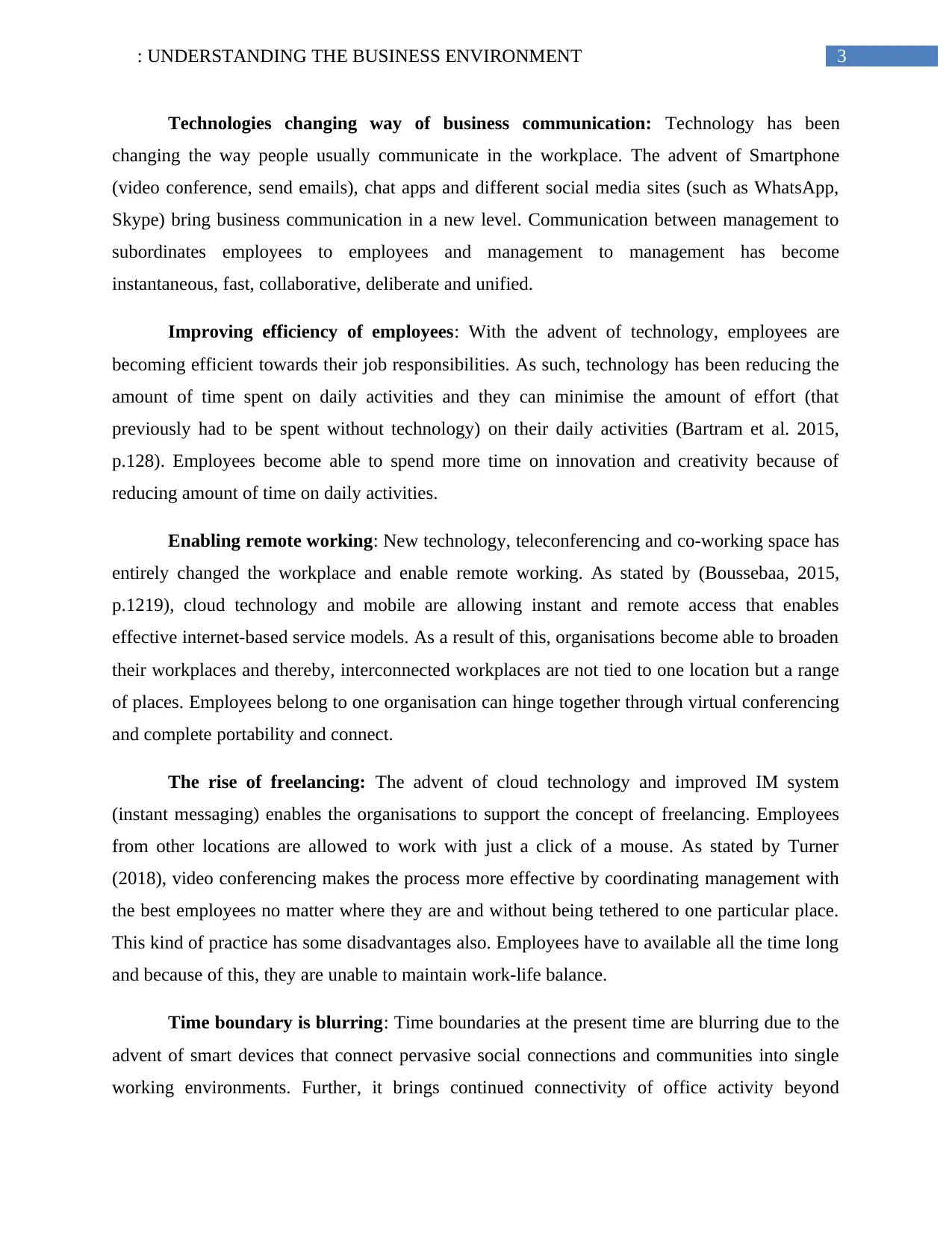
3: UNDERSTANDING THE BUSINESS ENVIRONMENT
Technologies changing way of business communication: Technology has been
changing the way people usually communicate in the workplace. The advent of Smartphone
(video conference, send emails), chat apps and different social media sites (such as WhatsApp,
Skype) bring business communication in a new level. Communication between management to
subordinates employees to employees and management to management has become
instantaneous, fast, collaborative, deliberate and unified.
Improving efficiency of employees: With the advent of technology, employees are
becoming efficient towards their job responsibilities. As such, technology has been reducing the
amount of time spent on daily activities and they can minimise the amount of effort (that
previously had to be spent without technology) on their daily activities (Bartram et al. 2015,
p.128). Employees become able to spend more time on innovation and creativity because of
reducing amount of time on daily activities.
Enabling remote working: New technology, teleconferencing and co-working space has
entirely changed the workplace and enable remote working. As stated by (Boussebaa, 2015,
p.1219), cloud technology and mobile are allowing instant and remote access that enables
effective internet-based service models. As a result of this, organisations become able to broaden
their workplaces and thereby, interconnected workplaces are not tied to one location but a range
of places. Employees belong to one organisation can hinge together through virtual conferencing
and complete portability and connect.
The rise of freelancing: The advent of cloud technology and improved IM system
(instant messaging) enables the organisations to support the concept of freelancing. Employees
from other locations are allowed to work with just a click of a mouse. As stated by Turner
(2018), video conferencing makes the process more effective by coordinating management with
the best employees no matter where they are and without being tethered to one particular place.
This kind of practice has some disadvantages also. Employees have to available all the time long
and because of this, they are unable to maintain work-life balance.
Time boundary is blurring: Time boundaries at the present time are blurring due to the
advent of smart devices that connect pervasive social connections and communities into single
working environments. Further, it brings continued connectivity of office activity beyond
Technologies changing way of business communication: Technology has been
changing the way people usually communicate in the workplace. The advent of Smartphone
(video conference, send emails), chat apps and different social media sites (such as WhatsApp,
Skype) bring business communication in a new level. Communication between management to
subordinates employees to employees and management to management has become
instantaneous, fast, collaborative, deliberate and unified.
Improving efficiency of employees: With the advent of technology, employees are
becoming efficient towards their job responsibilities. As such, technology has been reducing the
amount of time spent on daily activities and they can minimise the amount of effort (that
previously had to be spent without technology) on their daily activities (Bartram et al. 2015,
p.128). Employees become able to spend more time on innovation and creativity because of
reducing amount of time on daily activities.
Enabling remote working: New technology, teleconferencing and co-working space has
entirely changed the workplace and enable remote working. As stated by (Boussebaa, 2015,
p.1219), cloud technology and mobile are allowing instant and remote access that enables
effective internet-based service models. As a result of this, organisations become able to broaden
their workplaces and thereby, interconnected workplaces are not tied to one location but a range
of places. Employees belong to one organisation can hinge together through virtual conferencing
and complete portability and connect.
The rise of freelancing: The advent of cloud technology and improved IM system
(instant messaging) enables the organisations to support the concept of freelancing. Employees
from other locations are allowed to work with just a click of a mouse. As stated by Turner
(2018), video conferencing makes the process more effective by coordinating management with
the best employees no matter where they are and without being tethered to one particular place.
This kind of practice has some disadvantages also. Employees have to available all the time long
and because of this, they are unable to maintain work-life balance.
Time boundary is blurring: Time boundaries at the present time are blurring due to the
advent of smart devices that connect pervasive social connections and communities into single
working environments. Further, it brings continued connectivity of office activity beyond
Paraphrase This Document
Need a fresh take? Get an instant paraphrase of this document with our AI Paraphraser
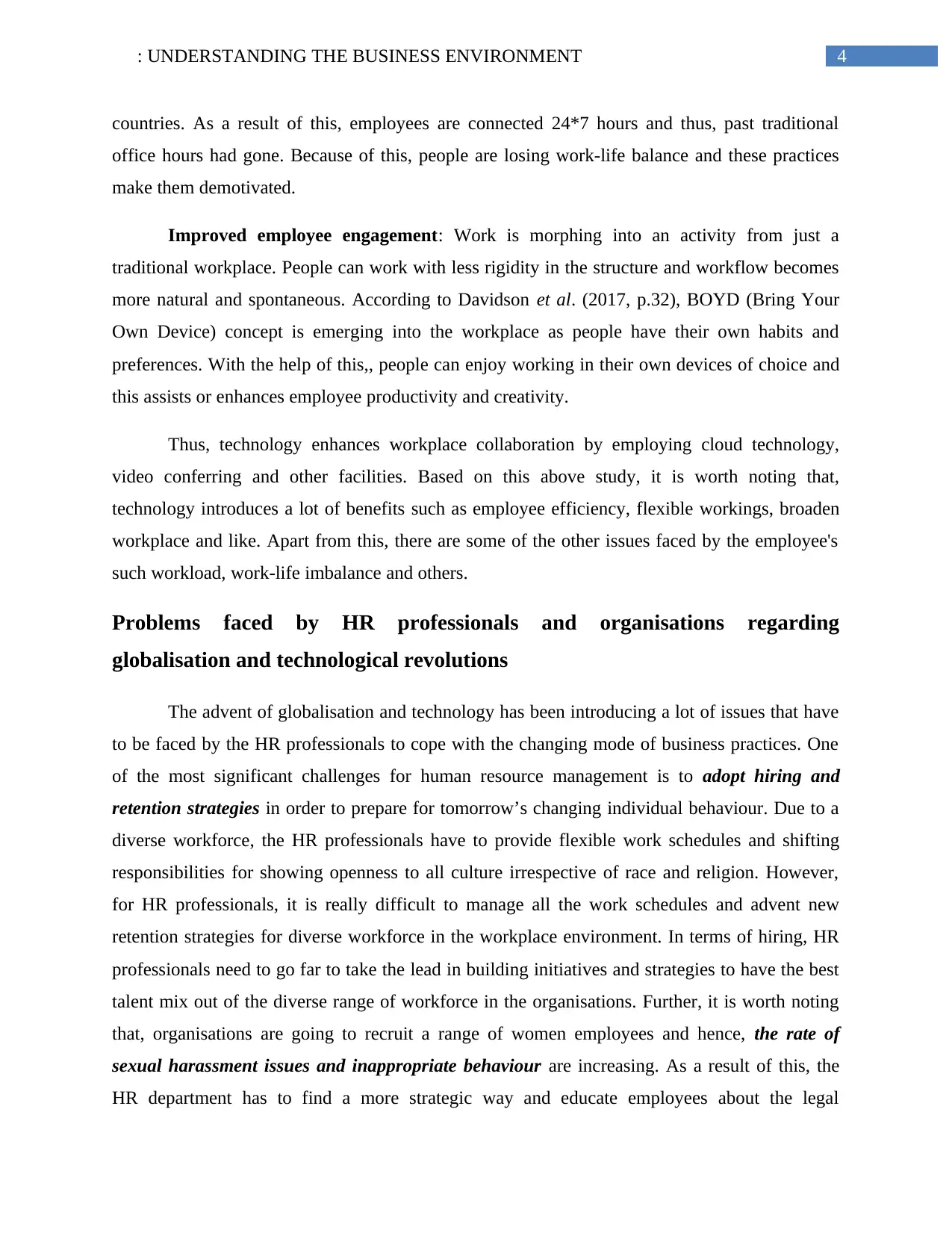
4: UNDERSTANDING THE BUSINESS ENVIRONMENT
countries. As a result of this, employees are connected 24*7 hours and thus, past traditional
office hours had gone. Because of this, people are losing work-life balance and these practices
make them demotivated.
Improved employee engagement: Work is morphing into an activity from just a
traditional workplace. People can work with less rigidity in the structure and workflow becomes
more natural and spontaneous. According to Davidson et al. (2017, p.32), BOYD (Bring Your
Own Device) concept is emerging into the workplace as people have their own habits and
preferences. With the help of this,, people can enjoy working in their own devices of choice and
this assists or enhances employee productivity and creativity.
Thus, technology enhances workplace collaboration by employing cloud technology,
video conferring and other facilities. Based on this above study, it is worth noting that,
technology introduces a lot of benefits such as employee efficiency, flexible workings, broaden
workplace and like. Apart from this, there are some of the other issues faced by the employee's
such workload, work-life imbalance and others.
Problems faced by HR professionals and organisations regarding
globalisation and technological revolutions
The advent of globalisation and technology has been introducing a lot of issues that have
to be faced by the HR professionals to cope with the changing mode of business practices. One
of the most significant challenges for human resource management is to adopt hiring and
retention strategies in order to prepare for tomorrow’s changing individual behaviour. Due to a
diverse workforce, the HR professionals have to provide flexible work schedules and shifting
responsibilities for showing openness to all culture irrespective of race and religion. However,
for HR professionals, it is really difficult to manage all the work schedules and advent new
retention strategies for diverse workforce in the workplace environment. In terms of hiring, HR
professionals need to go far to take the lead in building initiatives and strategies to have the best
talent mix out of the diverse range of workforce in the organisations. Further, it is worth noting
that, organisations are going to recruit a range of women employees and hence, the rate of
sexual harassment issues and inappropriate behaviour are increasing. As a result of this, the
HR department has to find a more strategic way and educate employees about the legal
countries. As a result of this, employees are connected 24*7 hours and thus, past traditional
office hours had gone. Because of this, people are losing work-life balance and these practices
make them demotivated.
Improved employee engagement: Work is morphing into an activity from just a
traditional workplace. People can work with less rigidity in the structure and workflow becomes
more natural and spontaneous. According to Davidson et al. (2017, p.32), BOYD (Bring Your
Own Device) concept is emerging into the workplace as people have their own habits and
preferences. With the help of this,, people can enjoy working in their own devices of choice and
this assists or enhances employee productivity and creativity.
Thus, technology enhances workplace collaboration by employing cloud technology,
video conferring and other facilities. Based on this above study, it is worth noting that,
technology introduces a lot of benefits such as employee efficiency, flexible workings, broaden
workplace and like. Apart from this, there are some of the other issues faced by the employee's
such workload, work-life imbalance and others.
Problems faced by HR professionals and organisations regarding
globalisation and technological revolutions
The advent of globalisation and technology has been introducing a lot of issues that have
to be faced by the HR professionals to cope with the changing mode of business practices. One
of the most significant challenges for human resource management is to adopt hiring and
retention strategies in order to prepare for tomorrow’s changing individual behaviour. Due to a
diverse workforce, the HR professionals have to provide flexible work schedules and shifting
responsibilities for showing openness to all culture irrespective of race and religion. However,
for HR professionals, it is really difficult to manage all the work schedules and advent new
retention strategies for diverse workforce in the workplace environment. In terms of hiring, HR
professionals need to go far to take the lead in building initiatives and strategies to have the best
talent mix out of the diverse range of workforce in the organisations. Further, it is worth noting
that, organisations are going to recruit a range of women employees and hence, the rate of
sexual harassment issues and inappropriate behaviour are increasing. As a result of this, the
HR department has to find a more strategic way and educate employees about the legal
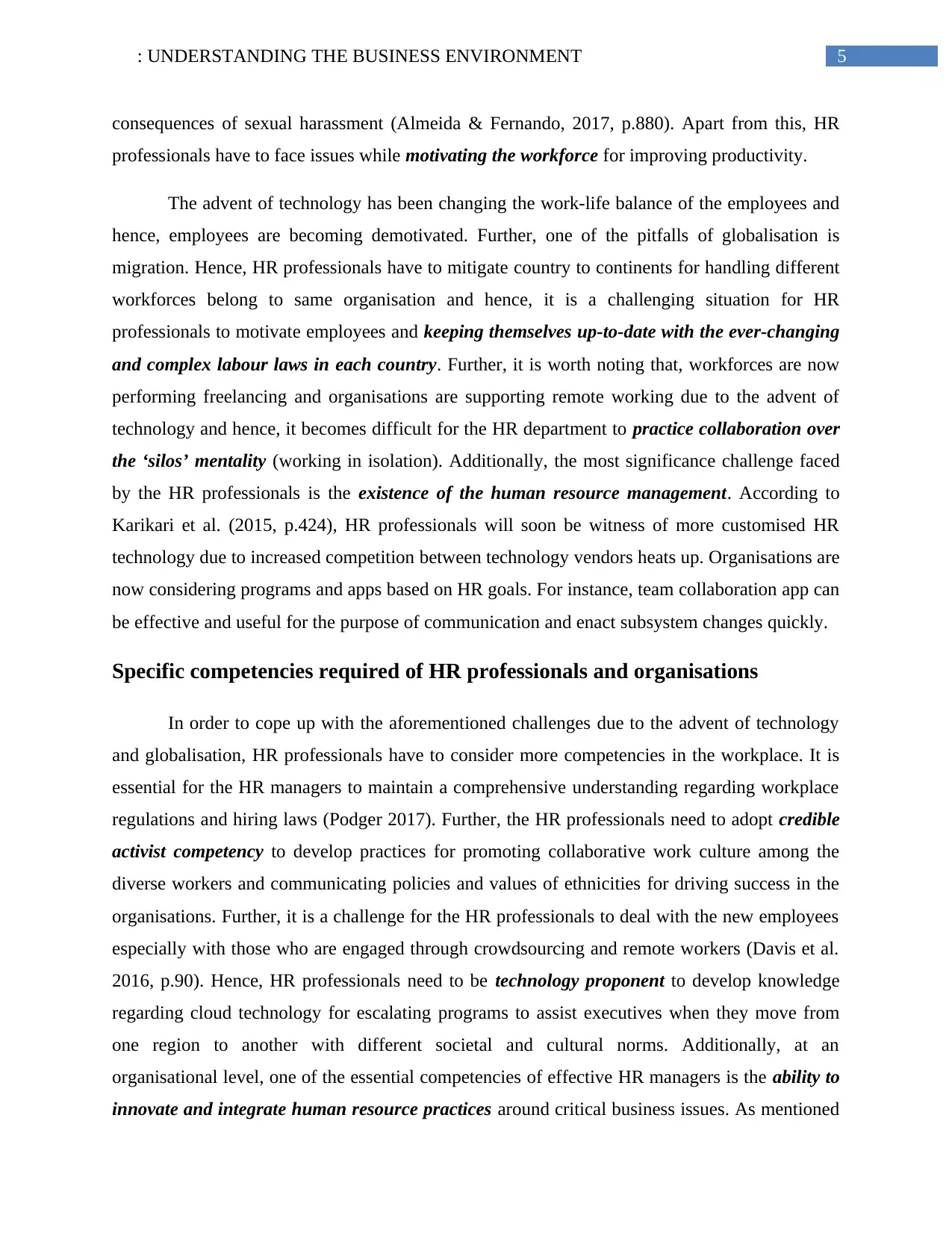
5: UNDERSTANDING THE BUSINESS ENVIRONMENT
consequences of sexual harassment (Almeida & Fernando, 2017, p.880). Apart from this, HR
professionals have to face issues while motivating the workforce for improving productivity.
The advent of technology has been changing the work-life balance of the employees and
hence, employees are becoming demotivated. Further, one of the pitfalls of globalisation is
migration. Hence, HR professionals have to mitigate country to continents for handling different
workforces belong to same organisation and hence, it is a challenging situation for HR
professionals to motivate employees and keeping themselves up-to-date with the ever-changing
and complex labour laws in each country. Further, it is worth noting that, workforces are now
performing freelancing and organisations are supporting remote working due to the advent of
technology and hence, it becomes difficult for the HR department to practice collaboration over
the ‘silos’ mentality (working in isolation). Additionally, the most significance challenge faced
by the HR professionals is the existence of the human resource management. According to
Karikari et al. (2015, p.424), HR professionals will soon be witness of more customised HR
technology due to increased competition between technology vendors heats up. Organisations are
now considering programs and apps based on HR goals. For instance, team collaboration app can
be effective and useful for the purpose of communication and enact subsystem changes quickly.
Specific competencies required of HR professionals and organisations
In order to cope up with the aforementioned challenges due to the advent of technology
and globalisation, HR professionals have to consider more competencies in the workplace. It is
essential for the HR managers to maintain a comprehensive understanding regarding workplace
regulations and hiring laws (Podger 2017). Further, the HR professionals need to adopt credible
activist competency to develop practices for promoting collaborative work culture among the
diverse workers and communicating policies and values of ethnicities for driving success in the
organisations. Further, it is a challenge for the HR professionals to deal with the new employees
especially with those who are engaged through crowdsourcing and remote workers (Davis et al.
2016, p.90). Hence, HR professionals need to be technology proponent to develop knowledge
regarding cloud technology for escalating programs to assist executives when they move from
one region to another with different societal and cultural norms. Additionally, at an
organisational level, one of the essential competencies of effective HR managers is the ability to
innovate and integrate human resource practices around critical business issues. As mentioned
consequences of sexual harassment (Almeida & Fernando, 2017, p.880). Apart from this, HR
professionals have to face issues while motivating the workforce for improving productivity.
The advent of technology has been changing the work-life balance of the employees and
hence, employees are becoming demotivated. Further, one of the pitfalls of globalisation is
migration. Hence, HR professionals have to mitigate country to continents for handling different
workforces belong to same organisation and hence, it is a challenging situation for HR
professionals to motivate employees and keeping themselves up-to-date with the ever-changing
and complex labour laws in each country. Further, it is worth noting that, workforces are now
performing freelancing and organisations are supporting remote working due to the advent of
technology and hence, it becomes difficult for the HR department to practice collaboration over
the ‘silos’ mentality (working in isolation). Additionally, the most significance challenge faced
by the HR professionals is the existence of the human resource management. According to
Karikari et al. (2015, p.424), HR professionals will soon be witness of more customised HR
technology due to increased competition between technology vendors heats up. Organisations are
now considering programs and apps based on HR goals. For instance, team collaboration app can
be effective and useful for the purpose of communication and enact subsystem changes quickly.
Specific competencies required of HR professionals and organisations
In order to cope up with the aforementioned challenges due to the advent of technology
and globalisation, HR professionals have to consider more competencies in the workplace. It is
essential for the HR managers to maintain a comprehensive understanding regarding workplace
regulations and hiring laws (Podger 2017). Further, the HR professionals need to adopt credible
activist competency to develop practices for promoting collaborative work culture among the
diverse workers and communicating policies and values of ethnicities for driving success in the
organisations. Further, it is a challenge for the HR professionals to deal with the new employees
especially with those who are engaged through crowdsourcing and remote workers (Davis et al.
2016, p.90). Hence, HR professionals need to be technology proponent to develop knowledge
regarding cloud technology for escalating programs to assist executives when they move from
one region to another with different societal and cultural norms. Additionally, at an
organisational level, one of the essential competencies of effective HR managers is the ability to
innovate and integrate human resource practices around critical business issues. As mentioned
⊘ This is a preview!⊘
Do you want full access?
Subscribe today to unlock all pages.

Trusted by 1+ million students worldwide
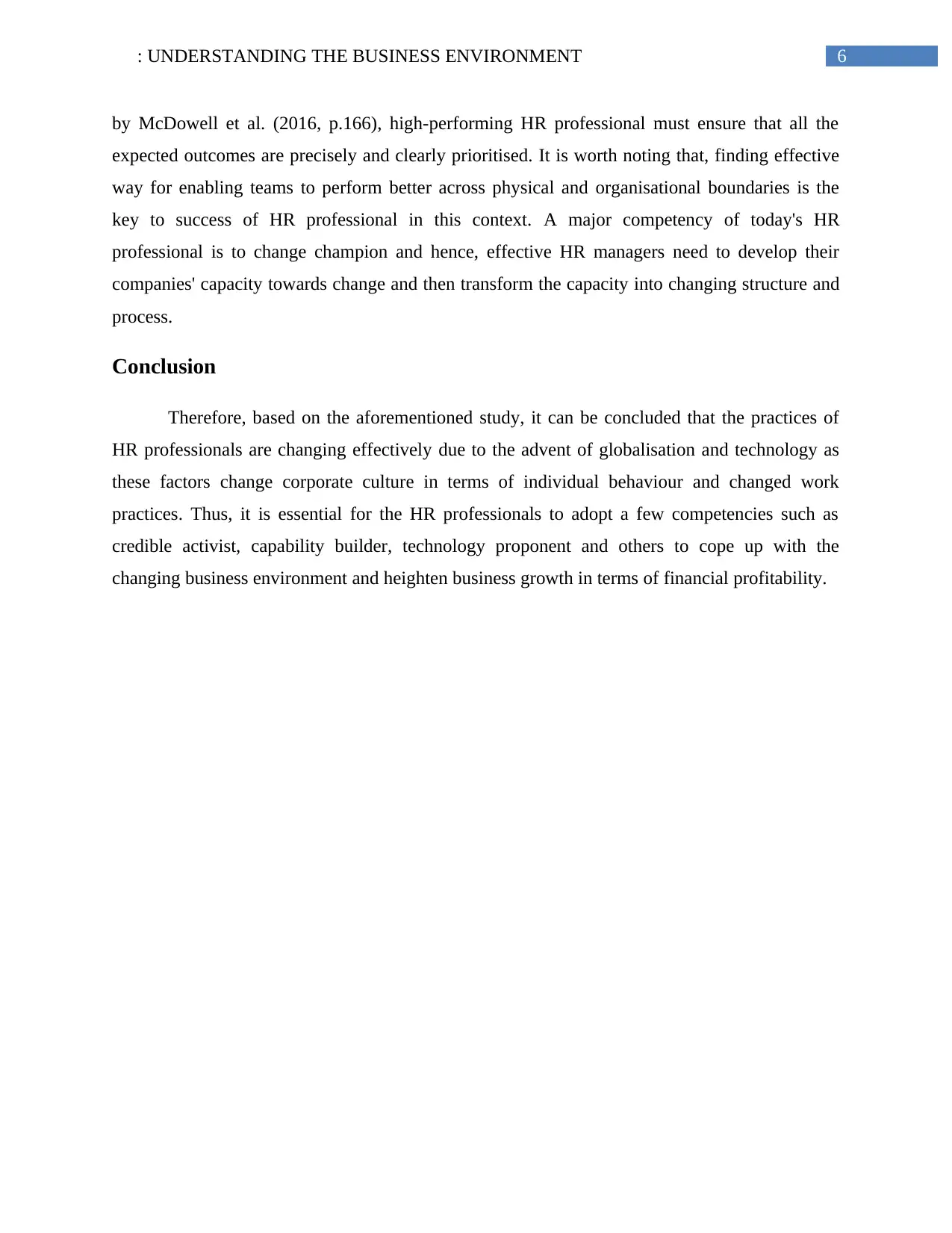
6: UNDERSTANDING THE BUSINESS ENVIRONMENT
by McDowell et al. (2016, p.166), high-performing HR professional must ensure that all the
expected outcomes are precisely and clearly prioritised. It is worth noting that, finding effective
way for enabling teams to perform better across physical and organisational boundaries is the
key to success of HR professional in this context. A major competency of today's HR
professional is to change champion and hence, effective HR managers need to develop their
companies' capacity towards change and then transform the capacity into changing structure and
process.
Conclusion
Therefore, based on the aforementioned study, it can be concluded that the practices of
HR professionals are changing effectively due to the advent of globalisation and technology as
these factors change corporate culture in terms of individual behaviour and changed work
practices. Thus, it is essential for the HR professionals to adopt a few competencies such as
credible activist, capability builder, technology proponent and others to cope up with the
changing business environment and heighten business growth in terms of financial profitability.
by McDowell et al. (2016, p.166), high-performing HR professional must ensure that all the
expected outcomes are precisely and clearly prioritised. It is worth noting that, finding effective
way for enabling teams to perform better across physical and organisational boundaries is the
key to success of HR professional in this context. A major competency of today's HR
professional is to change champion and hence, effective HR managers need to develop their
companies' capacity towards change and then transform the capacity into changing structure and
process.
Conclusion
Therefore, based on the aforementioned study, it can be concluded that the practices of
HR professionals are changing effectively due to the advent of globalisation and technology as
these factors change corporate culture in terms of individual behaviour and changed work
practices. Thus, it is essential for the HR professionals to adopt a few competencies such as
credible activist, capability builder, technology proponent and others to cope up with the
changing business environment and heighten business growth in terms of financial profitability.
Paraphrase This Document
Need a fresh take? Get an instant paraphrase of this document with our AI Paraphraser
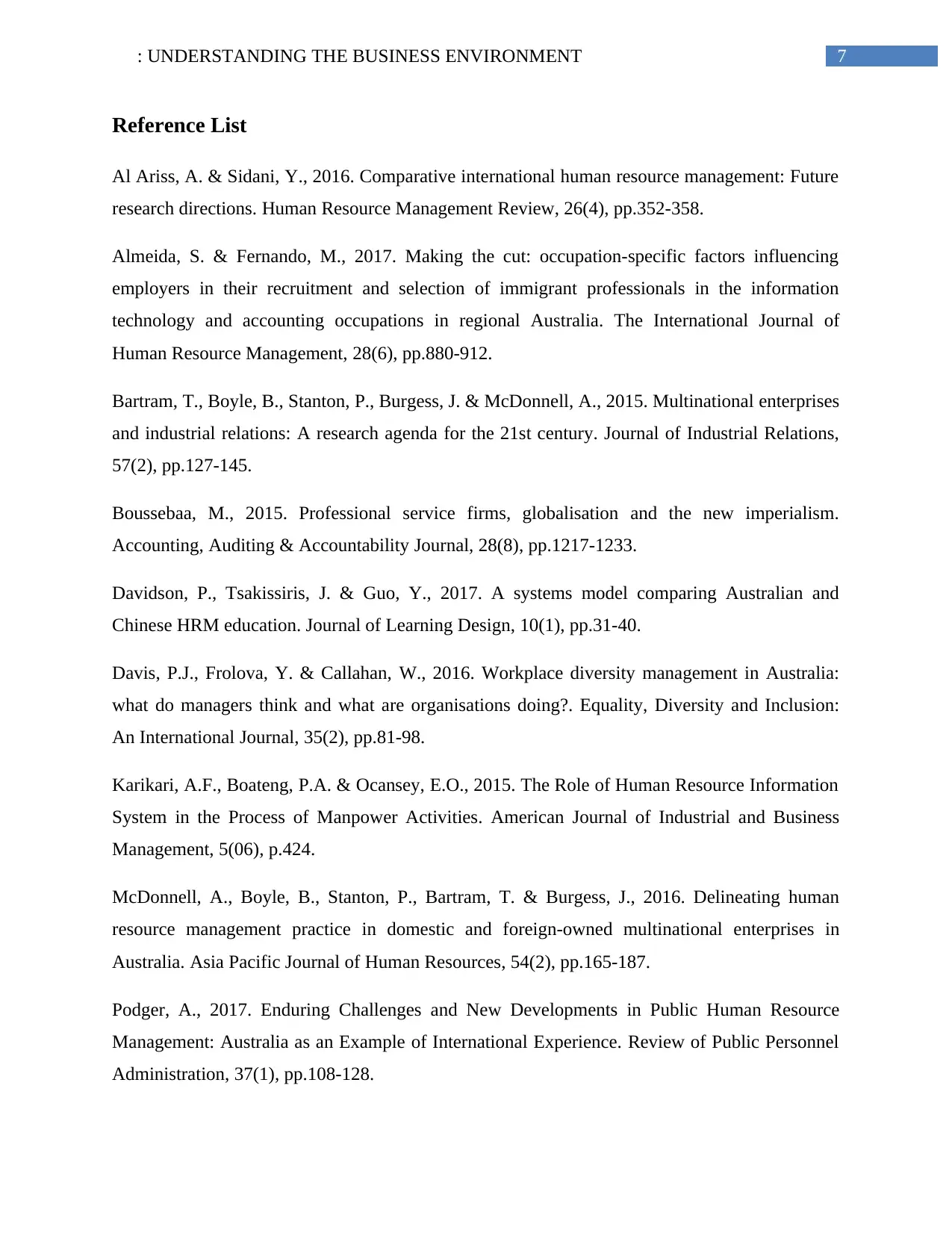
7: UNDERSTANDING THE BUSINESS ENVIRONMENT
Reference List
Al Ariss, A. & Sidani, Y., 2016. Comparative international human resource management: Future
research directions. Human Resource Management Review, 26(4), pp.352-358.
Almeida, S. & Fernando, M., 2017. Making the cut: occupation-specific factors influencing
employers in their recruitment and selection of immigrant professionals in the information
technology and accounting occupations in regional Australia. The International Journal of
Human Resource Management, 28(6), pp.880-912.
Bartram, T., Boyle, B., Stanton, P., Burgess, J. & McDonnell, A., 2015. Multinational enterprises
and industrial relations: A research agenda for the 21st century. Journal of Industrial Relations,
57(2), pp.127-145.
Boussebaa, M., 2015. Professional service firms, globalisation and the new imperialism.
Accounting, Auditing & Accountability Journal, 28(8), pp.1217-1233.
Davidson, P., Tsakissiris, J. & Guo, Y., 2017. A systems model comparing Australian and
Chinese HRM education. Journal of Learning Design, 10(1), pp.31-40.
Davis, P.J., Frolova, Y. & Callahan, W., 2016. Workplace diversity management in Australia:
what do managers think and what are organisations doing?. Equality, Diversity and Inclusion:
An International Journal, 35(2), pp.81-98.
Karikari, A.F., Boateng, P.A. & Ocansey, E.O., 2015. The Role of Human Resource Information
System in the Process of Manpower Activities. American Journal of Industrial and Business
Management, 5(06), p.424.
McDonnell, A., Boyle, B., Stanton, P., Bartram, T. & Burgess, J., 2016. Delineating human
resource management practice in domestic and foreign‐owned multinational enterprises in
Australia. Asia Pacific Journal of Human Resources, 54(2), pp.165-187.
Podger, A., 2017. Enduring Challenges and New Developments in Public Human Resource
Management: Australia as an Example of International Experience. Review of Public Personnel
Administration, 37(1), pp.108-128.
Reference List
Al Ariss, A. & Sidani, Y., 2016. Comparative international human resource management: Future
research directions. Human Resource Management Review, 26(4), pp.352-358.
Almeida, S. & Fernando, M., 2017. Making the cut: occupation-specific factors influencing
employers in their recruitment and selection of immigrant professionals in the information
technology and accounting occupations in regional Australia. The International Journal of
Human Resource Management, 28(6), pp.880-912.
Bartram, T., Boyle, B., Stanton, P., Burgess, J. & McDonnell, A., 2015. Multinational enterprises
and industrial relations: A research agenda for the 21st century. Journal of Industrial Relations,
57(2), pp.127-145.
Boussebaa, M., 2015. Professional service firms, globalisation and the new imperialism.
Accounting, Auditing & Accountability Journal, 28(8), pp.1217-1233.
Davidson, P., Tsakissiris, J. & Guo, Y., 2017. A systems model comparing Australian and
Chinese HRM education. Journal of Learning Design, 10(1), pp.31-40.
Davis, P.J., Frolova, Y. & Callahan, W., 2016. Workplace diversity management in Australia:
what do managers think and what are organisations doing?. Equality, Diversity and Inclusion:
An International Journal, 35(2), pp.81-98.
Karikari, A.F., Boateng, P.A. & Ocansey, E.O., 2015. The Role of Human Resource Information
System in the Process of Manpower Activities. American Journal of Industrial and Business
Management, 5(06), p.424.
McDonnell, A., Boyle, B., Stanton, P., Bartram, T. & Burgess, J., 2016. Delineating human
resource management practice in domestic and foreign‐owned multinational enterprises in
Australia. Asia Pacific Journal of Human Resources, 54(2), pp.165-187.
Podger, A., 2017. Enduring Challenges and New Developments in Public Human Resource
Management: Australia as an Example of International Experience. Review of Public Personnel
Administration, 37(1), pp.108-128.
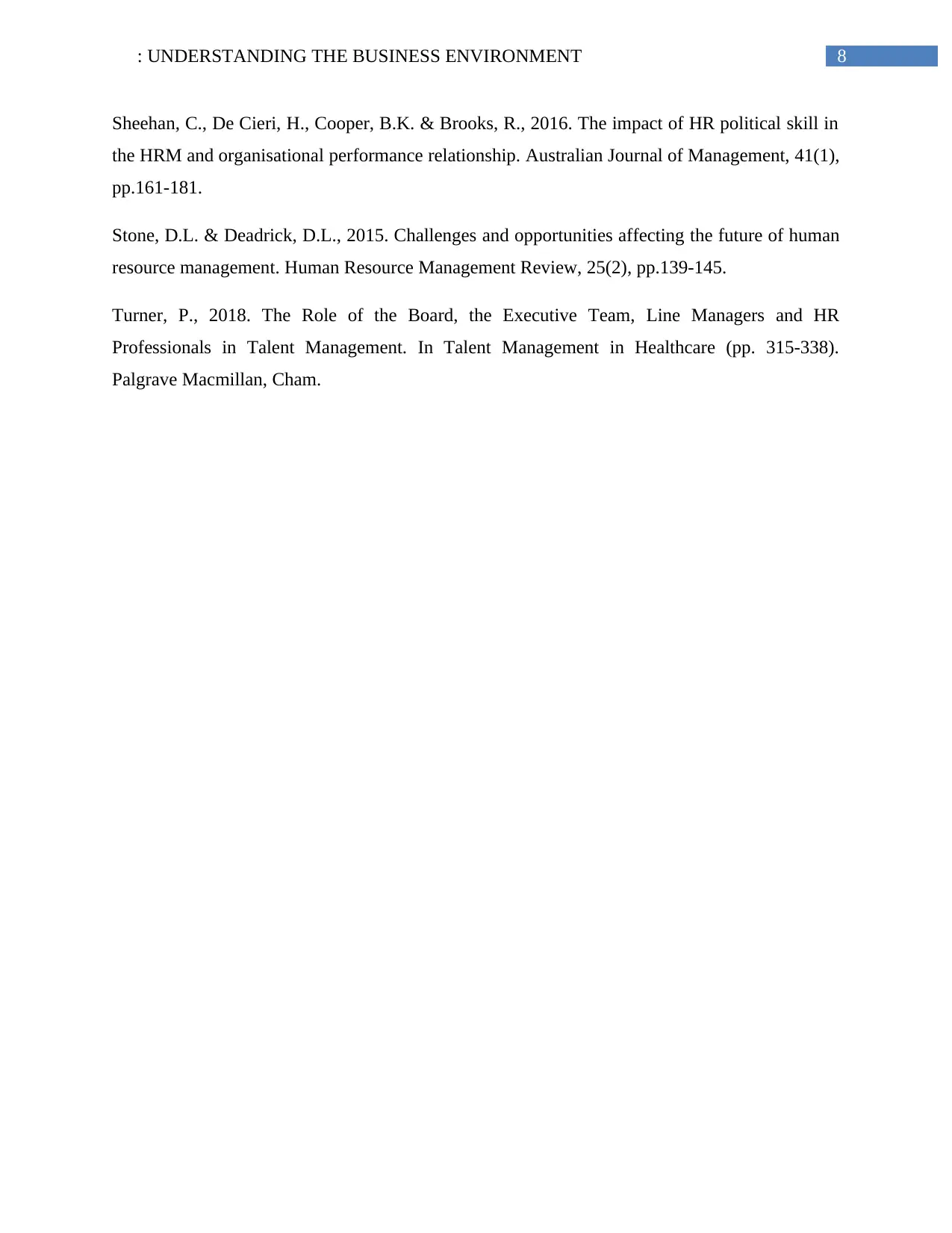
8: UNDERSTANDING THE BUSINESS ENVIRONMENT
Sheehan, C., De Cieri, H., Cooper, B.K. & Brooks, R., 2016. The impact of HR political skill in
the HRM and organisational performance relationship. Australian Journal of Management, 41(1),
pp.161-181.
Stone, D.L. & Deadrick, D.L., 2015. Challenges and opportunities affecting the future of human
resource management. Human Resource Management Review, 25(2), pp.139-145.
Turner, P., 2018. The Role of the Board, the Executive Team, Line Managers and HR
Professionals in Talent Management. In Talent Management in Healthcare (pp. 315-338).
Palgrave Macmillan, Cham.
Sheehan, C., De Cieri, H., Cooper, B.K. & Brooks, R., 2016. The impact of HR political skill in
the HRM and organisational performance relationship. Australian Journal of Management, 41(1),
pp.161-181.
Stone, D.L. & Deadrick, D.L., 2015. Challenges and opportunities affecting the future of human
resource management. Human Resource Management Review, 25(2), pp.139-145.
Turner, P., 2018. The Role of the Board, the Executive Team, Line Managers and HR
Professionals in Talent Management. In Talent Management in Healthcare (pp. 315-338).
Palgrave Macmillan, Cham.
⊘ This is a preview!⊘
Do you want full access?
Subscribe today to unlock all pages.

Trusted by 1+ million students worldwide
1 out of 9
Related Documents
Your All-in-One AI-Powered Toolkit for Academic Success.
+13062052269
info@desklib.com
Available 24*7 on WhatsApp / Email
![[object Object]](/_next/static/media/star-bottom.7253800d.svg)
Unlock your academic potential
Copyright © 2020–2025 A2Z Services. All Rights Reserved. Developed and managed by ZUCOL.




